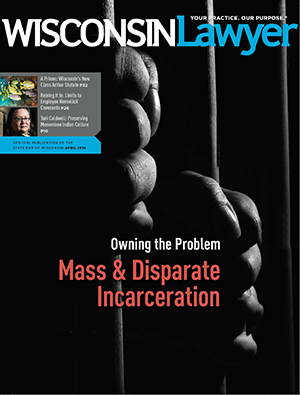 April 13, 2018 – The numbers support the facts: Wisconsin incarcerates non-white persons at far higher rates than whites and at rates of disparity far above the national average. How’d we get here? What are the costs to citizens, communities, and the justice system? What can be done?
April 13, 2018 – The numbers support the facts: Wisconsin incarcerates non-white persons at far higher rates than whites and at rates of disparity far above the national average. How’d we get here? What are the costs to citizens, communities, and the justice system? What can be done?
Mass Incarceration: Owning the Problem
In 1990, Wisconsin imprisoned approximately 6,000 people. Today, more than 23,000 people are incarcerated – in a prison system with a capacity far smaller. This explosion in our prison population has had enormous social and financial consequences for our state and its families, communities, and taxpayers. Last year, the State Bar began an initiative to bring together lawyers to study and find solutions to issues related to the incarceration crisis.
In “Wisconsin’s Mass & Disparate Incarceration: How Did We Get Here?,” U.W. Law School Prof. Mary Prosser and research assistant Shannon Toole look at the statistics behind the growth of incarceration in Wisconsin. They write, “While states from coast to coast and from the South to the Rust Belt have undertaken major initiatives to reduce prison populations and patterns of racial disparity, Wisconsin has not. Instead, Wisconsin’s prison population is accelerating upward, reaching and expected to surpass its highest historical numbers and matched by a rising budget and proposals for a new prison, on top of annual operating expenses in excess of $1 billion.” The numbers tell the story – and it’s not pretty.
Introduced by State Bar Presidents Fran Deisinger, Paul Swanson, and Chris Rogers, this article is the first in a series that examine the various and complicated issues of mass and disparate incarceration within Wisconsin’s criminal justice system.
Preventing Employees from Hiring Away Coworkers
In “Reining It In: Limits to Employee Nonsolicit Covenants,” Maria Kreiter, Maggie Cook, and Rebeca Lόpez examine the Wisconsin Supreme Court’s split decision in Manitowoc Co. v. Lanning, the first case in which a Wisconsin appellate court considered whether Wis. Stat. section 103.465 applies to nonsolicitation of employees provisions in employment agreements. The court held that such a provision was overbroad on its face because it applied to the solicitation of “any” employee.
In this case, the particular covenant failed to limit solicitation based on considerations such as the nature and competitive threat associated with the solicited employee’s position or the restricted employee’s personal familiarity with, or influence over, the solicited employee. Thus, the nonsolicitation provision was unenforceable under the statute. Given the result, the authors give tips for drafting enforceable restrictive covenants, consistent with the Lanning decision.
Practical Guidance for Class Action Lawsuits
In “A Primer: Wisconsin’s New Class Action Statute,” Michael Leffel, Elizabeth Haas, and Aaron Wegrzyn discuss the supreme court’s amendments to Wisconsin’s class action statute, Wis. Stat. section 803.08, to align it with its federal counterpart, Rule 23 of the Federal Rules of Civil Procedure. The revision provides practical guidance to lawyers bringing or defending against class action lawsuits in Wisconsin state court. The authors highlight the revised statute’s key requirements and concepts.
Other Columns
-
10 Questions: In “Preserving Menominee Indian Culture,” tribal attorney Toni Caldwell uses her legal skills in a variety of areas in tribal, state, and federal courts. Preserving her Menominee culture and values is what drives her.
-
Ethics: In “Of Counsel Lawyers Retain All Ethical Obligations,” Dean Dietrich writes the main distinction between of counsel lawyers and partners or shareholders is internal: the latter typically have billable-hour and revenue-goal expectations that the former do not. Yet, of counsel lawyers still have the same professional responsibilities.
-
On Balance: Paula Davis-Laack provides “6 New Leadership Skills to Develop for Tomorrow,” because in today’s era of change, innovation, and disruption, leaders must be curious and question existing rules that aren’t working.
-
Reflections: It’s never too early to follow this lesson from a retired lawyer and his 3-year-old grandson. In “Ben Time,” Bill Thedinga advises lawyers to stop, look both ways, then skip through the parking lot.
-
Marketing: In “’Okay Google’: How to Harness Voice Search,” Larry Bodine explains how savvy lawyers can capitalize on consumers’ fondness for voice searches, by tailoring their firms’ online content to the special characteristics of spoken requests for information.
-
Final Thought: Roy Evans says Black History Month is “My Favorite Time of Year.” He speaks to classrooms of students in the hope that something he might say will give them courage, direction, or inspiration to attain success in school as well as in life.
Check out the April Wisconsin Lawyer.
